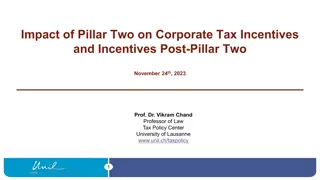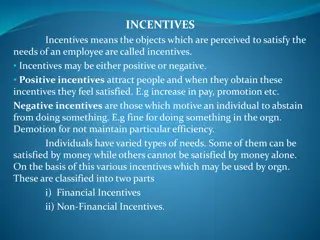Understanding Offshore Profit Shifting and Tax Incentives
Offshore profit shifting by multinational companies to low-tax countries can lead to understatement of U.S. profits, GDP, net exports, and productivity. Tax incentives, shifting mechanisms, measurement challenges, and apportionment logic are key aspects discussed in the content.
Download Presentation

Please find below an Image/Link to download the presentation.
The content on the website is provided AS IS for your information and personal use only. It may not be sold, licensed, or shared on other websites without obtaining consent from the author. Download presentation by click this link. If you encounter any issues during the download, it is possible that the publisher has removed the file from their server.
E N D
Presentation Transcript
Offshore Profit Shifting and the National Accounts Alan Auerbach November 9, 2018
Key Issue Tax incentives lead multinational companies to arrange activities to report profits in low- tax countries Leads to understatement of U.S. profits/ GDP/ net exports/ productivity If increasing over time, causes understatement of productivity growth
Outline What are the tax incentives? How does the shifting occur? How can one measure the shifting? How will tax policy changes affect behavior of multinationals?
Tax Incentives US tax system (pre-TCJA) High statutory corporate tax rate (35% federal) Worldwide tax system Tax active foreign-source income, but only when repatriated Tax passive foreign-source income immediately, but avoidable (e.g., through the use of disregarded entities ) So, strong incentive to locate U.S. profits abroad Note: incentive even stronger for foreign multinationals facing territorial tax systems
How Does Shifting Occur? Three main channels: 1. Borrow in U.S. to fund worldwide operations 2. Manipulate internal transfer prices to understate sales and overstate purchases 3. Use cost-sharing agreements & related mechanisms to shift location of IP 2 & 3 lead to reduced measure of domestic activity; 1 may also, if interest costs misstated, as through related party borrowing
How Does Shifting Occur? Note: similar results may occur even without shifting, if we lack adequate information E.g., if we miss elements of the supply chain, such as domestic IP incorporated in smartphone production abroad But tax-driven distortions appear really big
How to Measure the Shifting? Challenge: need counterfactual measure of where profits actually are located A big challenge, since the location of profits is not necessarily well-defined; e.g.: What is the location of intellectual property? Where are the profits of intellectual property earned ? Guvenen, Mataloni, Rassier & Ruhl (2018): Use average of location of 3rdparty sales and payroll to apportion worldwide profits
The Logic of Apportionment Use observable factors (e.g., payroll, sales, tangible assets) to determine the location of unobservable (profits) This logic is used by U.S. state-level corporate income taxes to apportion national profits Some have suggested doing the same at the national level Other approaches (e.g., OECD/BEPS) related But
The Logic of Apportionment Can only use for current purpose because countries don t use apportionment for tax purposes Otherwise, firms would distort observable factors; e.g., use higher capital-labor ratios in countries with high tax rates Sales and payroll are only rough indicators, except in special cases (e.g., constant factor shares)
How Will TCJA Affect Behavior? Significant changes in incentives facing multinationals, all discouraging profit shifting Lower rate (35 21): smaller incentive to shift GILTI (minimum tax on foreign earnings) works in the same direction BEAT (minimum tax on domestic earnings) reduces ability of companies to use transfer pricing manipulation Limits on interest deductibility FDII (export subsidy) encourages U.S. IP location
How Will TCJA Affect Behavior? Changes affecting location of real activity as well Lower US user cost of capital (tax rate cut, expensing) more domestic investment Tighter rules on profit shifting less domestic investment
Other Prospective Changes European digital tax initiative Initially put forward by the European Commission, but now proposed by UK Eyeball-based apportionment of worldwide income, but only for narrow group of companies Potentially big, but not necessarily in terms of impact on profit shifting
Summary Tax-induced profit shifting is large Difficulty in measuring it related to the difficulty in determining location of profits for tax purposes May be reduced in the coming years because of tax changes But other factors pointing in the opposite direction Increasing importance of multinational activity Increasing importance of IP relative to tangible assets























